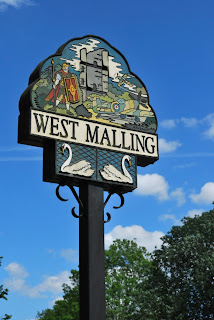 |
| St. Leonards Tower |
West Malling is a medieval town with a fascinating history, and there are plenty of sights to see if we just take the time to look for them.
As you approach the town centre the Norman church of St. Mary the Virgin stands on the highest ground in the area with its needle tower which was rebuilt in 1838. Further along the road on the left you’ll see the seventeenth century façade of the Tudor House which hides a medieval interior, as well as the town pump, the eighteenth century gothic Old Vicarage, and two original Georgian town houses, Forsters and Wisteria House.
 | ||||||
| Saint Mary's Church |
Of the two pubs that face each other at the top of the High Street, the Five Pointed Star was probably the first, constructed around 1380 as a farmhouse where ale may have been brewed. Across the road The Farmhouse, formerly known as The Bear, was a coaching inn famous for a Twisden family duel around 1700.
Continue along the High Street and turn left down West Street where you’ll see The Colonnade, a former malt loft and wagon shed with first floor doors. Turn right along King Street, an ancient Droveway which runs parallel to the High Street. Here you’ll see medieval timber framed buildings with jettied cross wing fronts including Avicia Cottage and The Prior’s House. Many buildings on King Street hide medieval structures behind more recent brick facades.
 |
| Looking back up the High Street |
 |
| West Malling |
Heading back along the High Street towards the centre, have a look at the fifteenth century house that is now Franks Mussel Bar. In the outer wall at pavement level there is a carved stone figure which is all that remains of the original Market Cross. On the other side of the road were the eighteenth century Assembly Rooms which housed a grand ballroom upstairs, and were later used as a Masonic temple and a magistrate’s court.
constructed to house important visitors to the Abbey. Further down Swan Street you’ll find the Abbey itself which was a nunnery founded by Bishop Gundulf around 1090. You can still see the original west tower from Swan Street, and the Cascade which originates from the late eighteenth century. On the opposite side of the road Went House and its railings are one of the best examples of Queen Anne architecture in Kent.
 | |
| Swan Street West Malling |
We’re often so busy with our daily routine that we forget to look around us and appreciate the
historic gem we have right here in West Malling, but hopefully this Easter you’ll have the chance to
enjoy it for yourself. Much of the information in this post was taken from the West Malling Town
Walk leaflet which is funded by Kent County Council and The Malling Society, and which is available
at the West Malling library.
We hope you enjoy your walk around West Malling.


